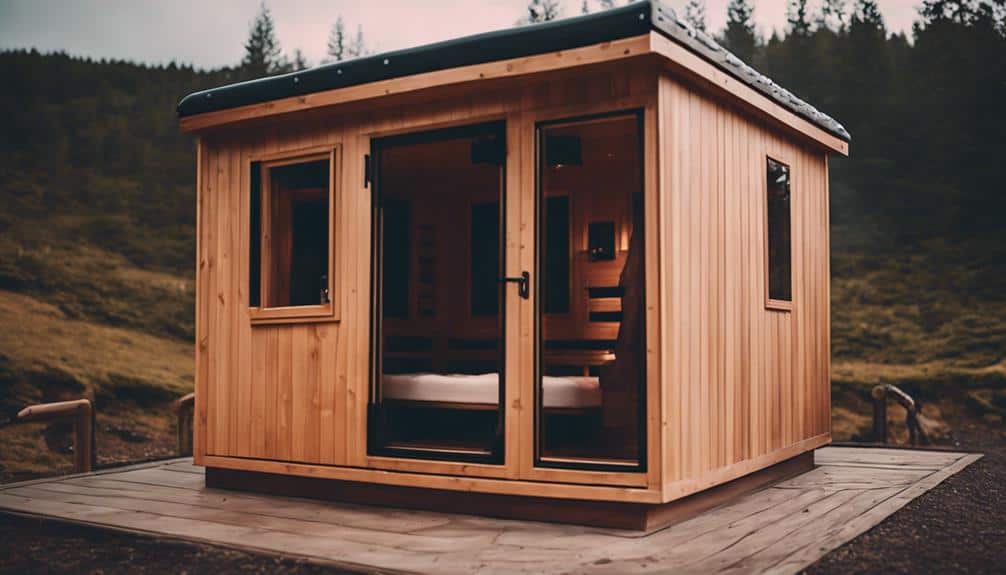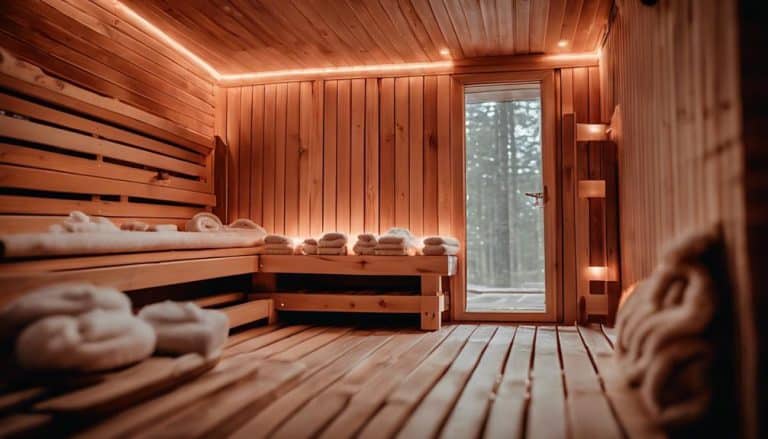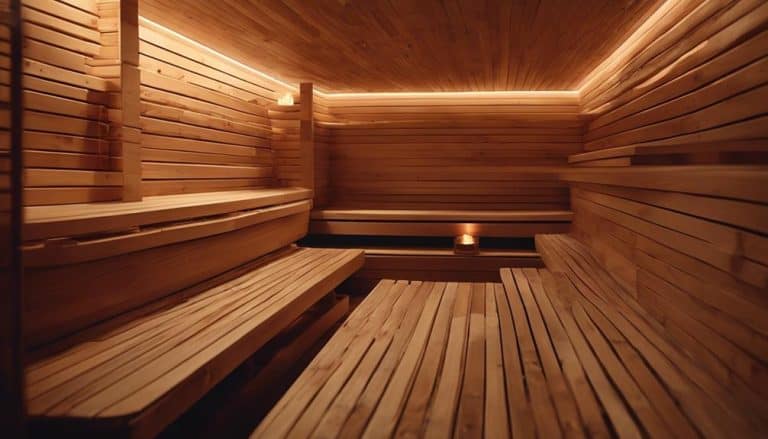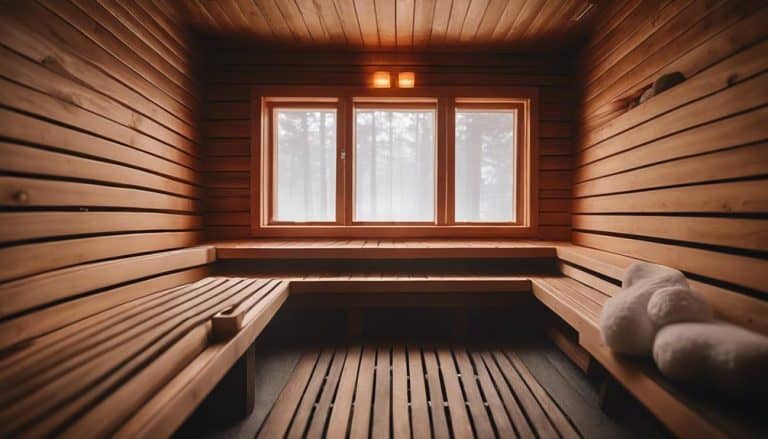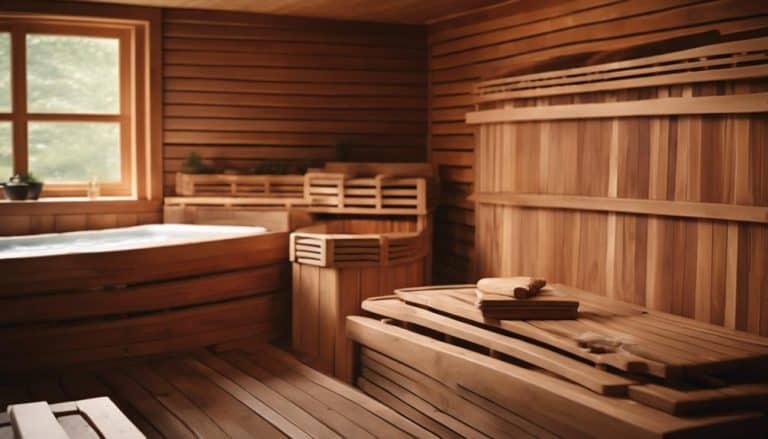10 Tips for Maximizing Electric Sauna Energy Efficiency
As I stepped into the sauna, the intense heat enveloped me like a warm embrace, instantly relaxing my muscles and easing away the stresses of the day.
But as I sat there, enjoying the therapeutic benefits, I couldn't help but wonder – is there a way to maximize the energy efficiency of this electric sauna?
Well, the good news is, there are indeed 10 tips that can help us achieve just that. From optimizing insulation to utilizing natural lighting, these tips can not only save energy but also reduce overall consumption.
So, if you're curious to know more about how you can make your electric sauna more energy-efficient, stick around.
Key Takeaways
- Properly insulate and seal the sauna to prevent heat loss and improve energy efficiency.
- Use a programmable thermostat and efficient heaters for precise temperature control and reduced energy consumption.
- Regularly maintain and clean sauna equipment to optimize performance and minimize energy wastage.
- Incorporate natural lighting, energy-efficient LED lighting, and advanced energy-saving strategies to further reduce electricity usage.
Optimize Sauna Insulation for Efficiency
To optimize sauna insulation for maximum efficiency, it's crucial to properly insulate the walls, ceiling, and door using materials such as mineral wool or foam board. This is essential for improving energy efficiency and preventing heat loss. By investing in high-quality insulation, you can significantly reduce electricity costs in the long run.
Insulation plays a vital role in maintaining a consistent temperature inside the sauna. It helps to seal any gaps or cracks in the sauna structure, preventing heat escape and ensuring that the sauna retains heat effectively. This not only enhances the overall comfort of the sauna experience but also reduces energy consumption.
Using mineral wool or foam board as insulation materials offers several benefits. These materials have excellent thermal resistance properties, which means they can effectively trap heat inside the sauna. Additionally, they're durable and resistant to moisture, ensuring that the insulation remains intact and efficient over time.
Properly insulating your sauna not only improves its energy efficiency but also helps to create a more comfortable and enjoyable sauna experience. By minimizing heat loss and maintaining a consistent temperature, you can maximize the effectiveness of your sauna while reducing electricity costs.
Use a Programmable Thermostat for Precise Temperature Control
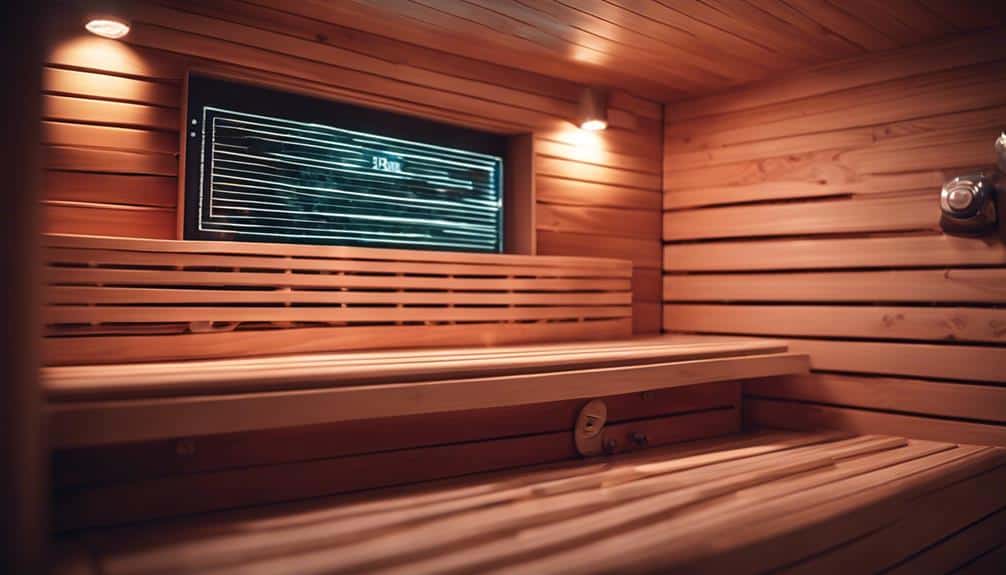
Using a programmable thermostat ensures precise temperature control and efficient energy use in the sauna. By allowing you to set specific temperature levels, a programmable thermostat helps optimize energy consumption and reduces costs.
This level of control is especially important in the sauna, as overheating can waste electricity and increase energy costs. With a programmable thermostat, you can schedule heating times to match your sauna sessions, ensuring that the sauna is only heated when needed. This not only saves energy but also maintains a consistent and comfortable sauna environment.
By avoiding unnecessary heating, you can reduce energy waste and lower your overall electricity consumption. A programmable thermostat is an essential tool for creating an energy-efficient sauna and maximizing energy efficiency. It provides the ability to precisely control the sauna temperature, ensuring that it's always at the desired level during your sauna sessions.
Investing in a programmable thermostat won't only help you save energy and reduce your energy costs but also enhance your overall sauna experience.
Choose Energy-Efficient Sauna Heaters
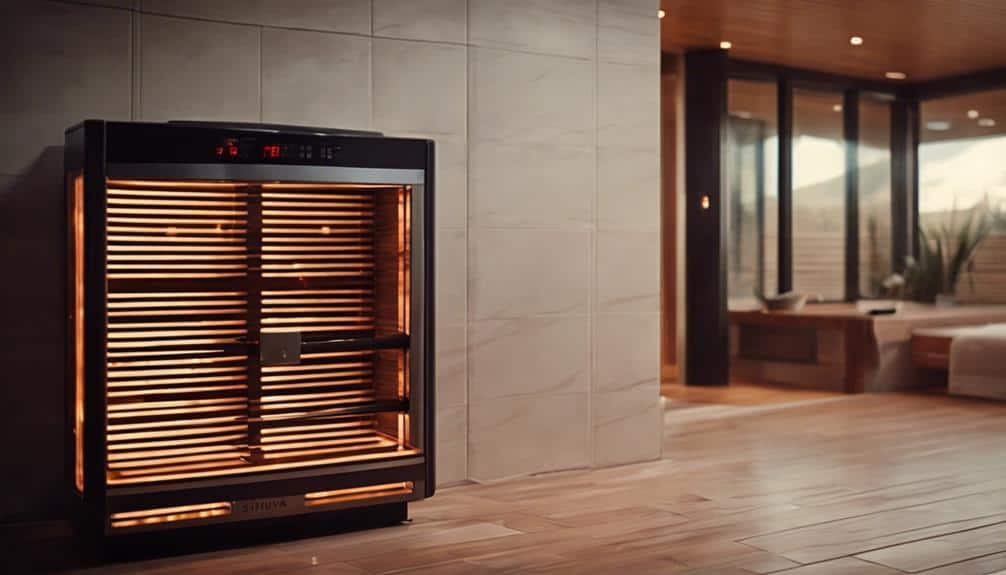
Energy-efficient sauna heaters are a key factor in maximizing energy efficiency and reducing electricity costs. When choosing electric heaters for your sauna, there are several factors to consider to ensure optimal energy consumption. Look for heaters with high efficiency and low wattage, as they'll be more cost-effective in the long run. Consider Energy Star certified heaters, which are designed to meet strict energy efficiency guidelines and can help you save even more on your electricity bills.
The size of your sauna is also an important factor to consider when choosing an energy-efficient heater. Make sure to select a heater that's appropriate for the size of your sauna to avoid unnecessary energy waste. Additionally, infrared sauna heaters are known for their high efficiency and lower energy consumption compared to traditional electric heaters. They can provide a comfortable sauna experience while minimizing energy costs.
To further maximize energy efficiency, it's recommended to reduce preheating time by using a timer or programmable thermostat. This way, you can ensure that your sauna is heated to the desired temperature at the right time, avoiding unnecessary energy usage.
Regularly Clean and Maintain Sauna Equipment

Regularly cleaning and maintaining sauna equipment is essential for optimizing energy efficiency and ensuring optimal performance. One important aspect of maintenance is cleaning sauna stones. Over time, these stones can accumulate dirt and debris, which can hinder their ability to transfer heat effectively. By regularly cleaning the sauna stones, you can ensure that they're able to distribute the heat evenly throughout the sauna, leading to better energy efficiency and a more comfortable sauna experience.
Another crucial component to maintain is the sauna heater. Inspecting and cleaning the heater elements regularly is vital for optimal performance and energy efficiency. Dirty or damaged heater elements can lead to inefficient heat generation, resulting in higher electricity bills. By keeping the heater elements clean and in good condition, you can ensure that the sauna operates efficiently and effectively.
Proper airflow is also key to maximizing energy efficiency in the sauna. It's important to clean air vents and ensure that there's adequate ventilation within the sauna. This allows for better heat distribution and prevents energy wastage. Additionally, checking and promptly replacing any damaged parts will prevent energy wastage and maintain the sauna's efficiency.
To stay on top of maintenance tasks, it's helpful to create a regular maintenance schedule. This ensures that cleaning and maintenance activities are carried out consistently, minimizing the risk of energy wastage and promoting optimal energy efficiency. By following a maintenance schedule, you can prolong the lifespan of your sauna equipment and keep your electricity bills in check.
Utilize Natural Lighting to Reduce Electricity Usage

To reduce electricity usage in your sauna, consider utilizing natural lighting sources such as windows or skylights. Position your sauna in a way that takes advantage of natural light sources to minimize the need for electric lighting. Incorporate reflective surfaces or light-colored materials in your sauna design to enhance the distribution of natural light. This will create a brighter and more energy-efficient environment.
When it comes to artificial lighting, opt for energy-efficient LED lighting or solar-powered lighting solutions. LED lighting consumes less electricity and has a longer lifespan compared to traditional incandescent bulbs. Solar-powered lighting, on the other hand, harnesses the power of the sun to illuminate your sauna, reducing dependence on the electrical grid.
Minimize Sauna Session Duration for Energy Conservation

When aiming to conserve energy, one effective approach is to minimize the duration of sauna sessions. Shortening sauna session duration can significantly reduce energy consumption, helping to conserve electricity and minimize operating costs. By limiting sauna time to essential needs, we can promote energy efficiency and lower power usage. Efficient use of sauna time not only contributes to energy conservation but also decreases overall power usage, leading to lower energy bills.
To minimize sauna session duration for energy conservation, it's important to plan and prioritize your time in the sauna. Set a specific time limit for each session and stick to it. Avoid lingering in the sauna unnecessarily, as this will only increase power usage and operating costs. Focus on the essential benefits of the sauna and avoid spending excessive time inside.
Additionally, consider using a timer or alarm to ensure that you don't exceed the designated sauna session duration. This will help you stay on track and avoid wasting energy.
Implement Time-Of-Use Electricity Rates for Cost Savings
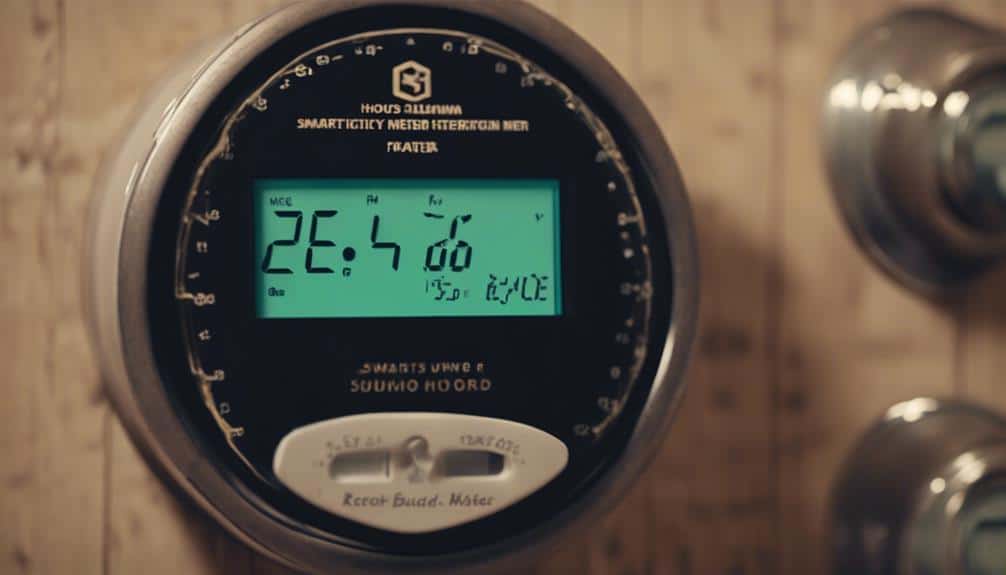
Implementing time-of-use electricity rates can result in substantial cost savings on your overall electricity bill when using your electric sauna. Time-of-use rates offer lower costs during off-peak hours, which are typically the times when demand for electricity is lower. By running your sauna during these cheaper electricity periods, you can save significantly on energy expenses.
To take advantage of time-of-use rates, it's important to monitor peak and off-peak hours. Most utility companies provide information about these periods, which can vary depending on your location. By planning your sauna sessions during off-peak hours, you can maximize your cost savings.
In addition to the savings on your electricity bill, some utility companies also offer incentives for shifting energy usage to off-peak times. These incentives can further reduce your energy expenses and make it even more advantageous to operate your sauna during off-peak hours.
Implementing time-of-use electricity rates for your electric sauna is a practical and effective way to save on energy costs. By taking advantage of the lower rates during off-peak hours and aligning your sauna usage with these periods, you can enjoy the benefits of your sauna while minimizing your energy expenses.
Consider Solar-Powered Options for Sustainable Energy
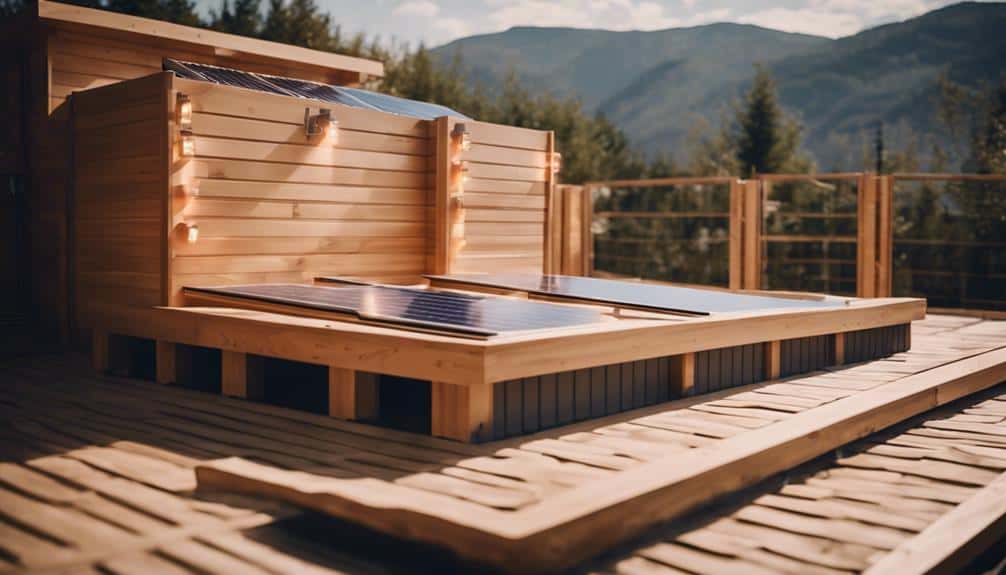
Considering solar-powered options is a sustainable and cost-effective way to reduce electricity costs for your electric sauna. Solar-powered saunas utilize renewable energy from the sun, making them an environmentally friendly and sustainable power source. By installing solar panels for sauna heating, you can significantly lower your carbon footprint while ensuring energy efficiency.
Solar energy is a renewable resource, meaning it will never run out. This makes it a reliable and long-term solution for heating your electric sauna. By harnessing the power of the sun, you can reduce your reliance on traditional electricity sources and decrease your electricity costs in the long run.
Not only are solar-powered saunas cost-effective and sustainable, but they also provide a practical and efficient heating solution. By utilizing solar power, you can heat your sauna efficiently, ensuring that the energy is used effectively and minimizing any heat loss.
Incorporating solar-powered options into your electric sauna not only helps you save money on electricity costs but also contributes to a greener and more sustainable future. By reducing your reliance on non-renewable energy sources, you're actively taking steps towards a more environmentally friendly lifestyle. Consider solar-powered options for your electric sauna to maximize energy efficiency and reduce your carbon footprint.
Properly Seal Sauna Doors and Windows to Prevent Heat Loss
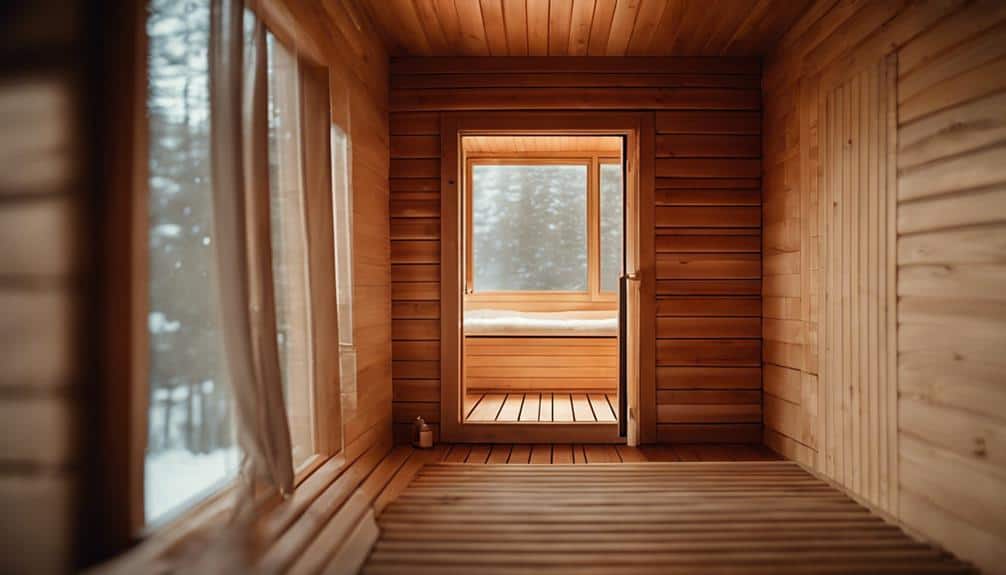
To prevent heat loss and maximize energy efficiency in your electric sauna, ensure that sauna doors and windows are properly sealed. Sealing these openings is crucial for preventing heat from escaping and cold air from entering, thus reducing heat loss and improving insulation. By using weather stripping and sealing any gaps, you can effectively maintain the sauna's temperature and create a comfortable environment. Properly sealed sauna doors and windows can reduce heat loss by up to 30%, which translates to significant energy savings and reduced heating costs.
To achieve proper sealing, start by inspecting the doors and windows for any gaps or cracks. Apply weather stripping to create an airtight seal and prevent heat loss. It's important to choose weather stripping materials that can withstand the high temperatures and humidity levels inside the sauna. Silicone or rubber weather stripping often works best.
Additionally, check the hinges and latches on the doors to ensure they're functioning properly and closing tightly. If necessary, adjust or replace them to create a tight seal. Remember, every small gap can contribute to heat loss and increased energy consumption.
Educate Yourself on Energy-Saving Sauna Practices
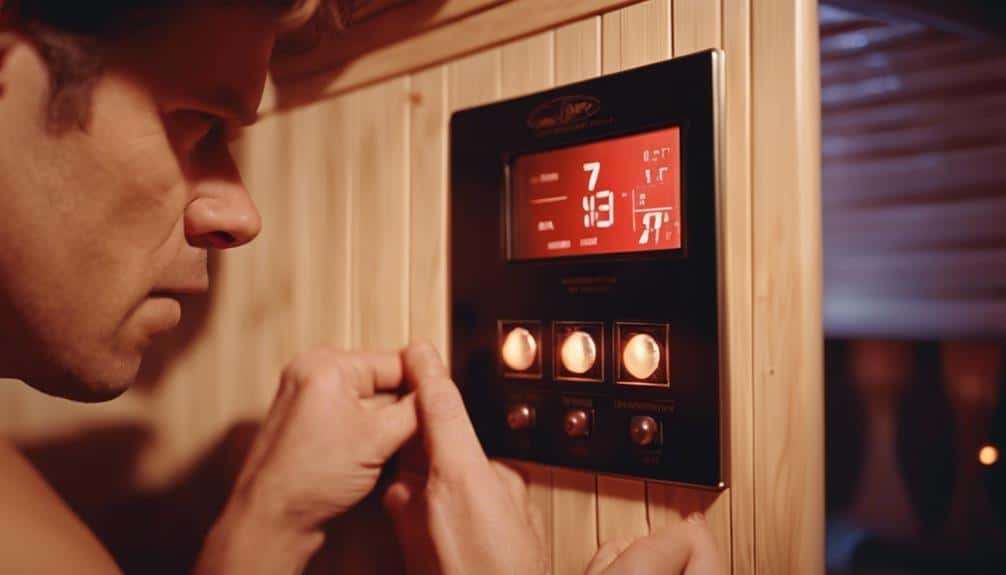
Now that you have properly sealed your sauna doors and windows, it's important to educate yourself on energy-saving sauna practices to further maximize energy efficiency. Electric saunas are known to consume around 5 kWh per hour, with an estimated usage of 2.5 kWh per person. To reduce energy consumption, consider choosing energy-efficient models that are designed to optimize heat retention. Additionally, utilizing timers can help regulate the usage and prevent unnecessary energy wastage.
Another option to consider is the use of infrared saunas. These saunas offer immediate health benefits without the need for preheating, which can help reduce energy consumption compared to traditional electric saunas. Infrared saunas operate using infrared radiation, which directly heats the body instead of the surrounding air. This technology is comparable to the energy consumption of household appliances, making it an efficient choice for maximizing energy savings.
To ensure efficient usage, it's important to follow the manufacturer's instructions and guidelines for operating the sauna. This includes setting the desired temperature and duration for your sauna sessions. By being mindful of your energy consumption and adopting energy-saving practices, you can enjoy the health benefits of saunas while minimizing your environmental impact and maximizing energy savings.
Frequently Asked Questions
Do Electric Saunas Use a Lot of Electricity?
Electric saunas can use a significant amount of electricity. However, there are ways to reduce energy consumption, such as using energy-efficient models, optimizing usage time, and implementing eco-friendly practices to lower electricity costs.
How Can I Maximize My Sauna Benefits?
To maximize my sauna benefits, I follow sauna rituals, use essential accessories, experiment with different temperatures, practice sauna etiquette, and employ relaxation techniques. Regular maintenance and safety precautions are also crucial for optimal sauna experience.
What Is the Cheapest Way to Heat a Sauna?
The cheapest way to heat a sauna is by using wood-burning saunas or solar powered saunas. These options require minimal electricity consumption and can be cost-effective in the long run.
How Can I Make My Sauna Sustainable?
To make my sauna sustainable, I focus on eco-friendly options, energy-saving accessories, and sustainable materials. I reduce energy consumption by insulating properly, using timers, and exploring renewable energy sources. I also prioritize environmentally conscious maintenance.
Conclusion
In the quest for electric sauna energy efficiency, maintaining and optimizing the sauna's insulation, utilizing programmable thermostats, choosing energy-efficient heaters, and regular cleaning and maintenance are crucial.
Seal doors and windows properly to prevent heat loss, and consider solar-powered options for sustainable energy.
By implementing these practical tips and educating yourself on energy-saving practices, you can create a harmonious rhythm between comfort and conservation in your sauna experience.

